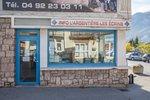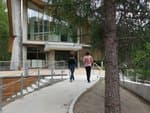THEMED PATH: Industrial circuit walk
Description
Setting out from the Tourist Information Office of L'Argentière-La Bessée, follow the banks of the Durance towards the red bridge.
- When you come to the red bridge, cross it and then take the narrow footpath on the left.
- Turn left and make a there-and-back detour to see the arch bridge: go past a garage to reach a promontory which takes you close to the bridge, and then retrace your steps. Carry on, passing the former Péchiney factory, and then take the Rue de l'Industrie where there is an exhibition of photographs on the walls.
- Turn right at the roundabout and cross the road to read the information panel on the Francis water turbine. Carry on towards the railway bridge and go under it through an underpass, to reach the explanatory panel about the Mines du Fournel wagon. Retrace your steps back to the Francis turbine panel and continue straight ahead, past the mobile compressor. At the next roundabout, go right to the impressive aluminium bar.
- From the aluminium bar, cross the road heading towards the station, to discover the shunting locomotive. Go back to the main road of L'Argentière-La Bessée and carry on towards the town hall ("Mairie"). After admiring the enormous ice-pick in front of the town hall, carry on towards the bridge which takes you across the Durance and back to the Tourist Information Office.
- Departure : Tourist information office ("Bureau d’Information Touristique") in L’Argentière-La Bessée
- Arrival : Tourist information office ("Bureau d’Information Touristique") in L’Argentière-La Bessée
- Towns crossed : L'Argentière-la-Bessée
Altimetric profile
Recommandations
Information panels are provided all along the route.
Les écrins sentiers thématiques Smartphone app can be downloaded.
Check weather conditions before setting off.
Rescue services contact details: Secours Montagne (Mountain Rescue): +33 (0)4 92 22 22 22 or 112
Show consideration for the work of farmers, livestock keepers and owners
Close all gates behind you
Take your litter home
Do not take shortcuts across pastureland
Information desks
23 Avenue de la République, 05120 L'Argentière-La Bessée
Vallouise Park house
, 05290 Vallouise
Information, documentation, models, exhibitions, screenings, product sales and works of the Park. Guided tours for school, reservation required. The new Park House opened in Vallouise since June 1, and offers visitors an interactive permanent exhibition inviting to explore the area and its heritage. A temporary exhibition space will allow a renewed offer. Finally, the device is completed by an audiovisual room to organize screenings and conferences Free admission. All animations of the Park are free unless otherwise stated.
Transport
Public transport >> www.pacamobilite.fr
Consider car-sharing >> www.blablacar.fr
For more information, ask at the Tourist Information Office nearest to the trail starting point.
Access and parking
16 km from Briançon, take the N94.
Parking :
Sensitive areas
Short-toed snake eagle
- Impacted practices:
- Aerial,
- Sensitivity periods:
- MarAprMayJunJulAugSep
- Contact:
- Parc National des Écrins
Julien Charron
julien.charron@ecrins-parcnational.fr
9 points of interest
 History
HistoryThe vertical compressor
In 1910, a 22-year-old engineer, Gilbert Planche arrived in L'Argentière-La Bessée to take advantage of the water here and open a large aluminium factory.
The vertical compressor is the forerunner of the pneumatic drill. The mine operators needed a large quantity of coal and compressed air helped to accelerate coal output. In 1852, Swiss physicist Jean-Daniel Colladon invented the pneumatic drill. The vertical compressor enabled the production of compressed air which powered a drill and simplified coal excavation. The compressor is placed vertically on its support, hence its name.
 History
HistoryLouis Leprince-Ringuet and L'Argentière
Louis Leprince-Ringuet was the director of the Physics Laboratory of X ("X" being a polytechnic school in Villeurbanne) established in L'Argentière. During the summer of 1942, he took in several Jewish students, thus saving them from the Nazis and deportation to Auschwitz. A panel presents the discoveries made by Louis Leprince-Ringuet in this laboratory. A text by Bernard Lévi is also displayed. As a young Jewish student, he took part in research at the laboratory during the summer of 1942. In it he thanks the scientific team for helping him to escape the anti-Semitic barbarism.
 History
HistoryThe Péchiney factory
This French electro metal company established itself in L'Argentière in 1907. The construction of the aluminium factory started in 1909 and it opened its doors in 1910, powered by the electricity plant built by Gilbert Planche. With it, L'Argentière became an industrial town. The economic crisis of the 1970s and the rise of foreign sources of supply led to the factory's closure in 1985. It was partially demolished in 1988. The workers left the town and in order to prevent the abandonment of L'Argentière, a restructuring project was launched.
 History
HistoryFormer industrial area of L’Argentière-la-Bessée
On the two walls of these now-disused industrial structures, you can read the history of L’Argentière-la-Bessée. The town is marked by its industrial past, in particular by the presence of a hydroelectric power station built between 1907 and 1909 to harness the power of the mountain waterfalls. At the time, it was the most powerful power station in Europe. Other industries were also established here, like the Société du Quartz Fondu fused quartz works and the aluminium factory which provided livelihoods for a large number of workers. History
HistoryThe Francis turbine
The American James Francis developed the Francis turbine between 1849 and 1855. It is a “àreaction” turbine suitable for medium-sized waterfalls (with a water head of between 15 and 500 metres). The water enters the turbine and then circulates between the turbine blades, which are fixed, while the inner wheel is mobile. The pressure at the wheel intake is greater than the pressure at the outlet.
 History
HistoryThe mobile compressor
In the mines, compressed air is used to remove dust and to create power for the drills. The mobile compressor holds compressed air in a resistant tank. This is brought to a high pressure via a pump (the compressor). The compressed air is then distributed to the mine machinery through a conduit system.
 History
HistoryThe giant aluminium bar
A young metal, aluminium is the most abundant metallic element on earth. Today, the aluminium industry is the second biggest after steel.
This enormous ingot was made in L'Argentière-La Bessée.
 History
HistoryThe light rail tractor
A locomotive? No, its little cousin, the light rail tractor. This replaced manually pushed carts and horse-drawn vehicles. Less powerful than a locomotive, it travelled along narrow-gauge tracks which could be laid on different types of terrain. An information panel also described the role of this vehicle during the Great War.
 History
HistoryThe old workers' housing districts
Workers' housing districts were built to house the many workers who were employed at the Péchiney factory. These districts have now been demolished. The architecture of the houses varied according to the status of the employee. A town hall, a cinema, a bandstand and churches were also constructed.
Accessibility
Source

Report a problem or an error
If you have found an error on this page or if you have noticed any problems during your hike, please report them to us here:


